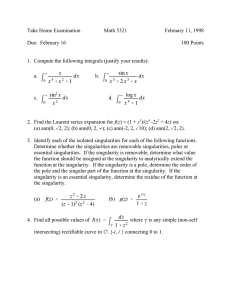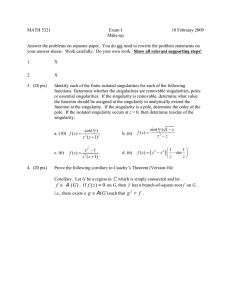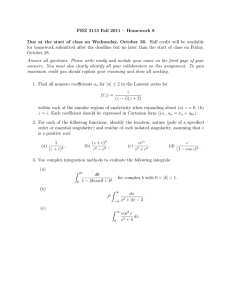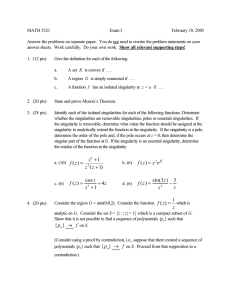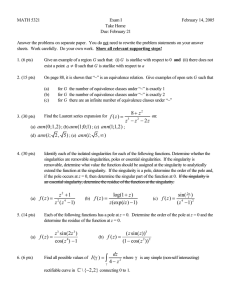Connection between Phase Singularities and the Radiation Pattern of a... Hugo F. Schouten, Taco D. Visser,* Greg Gbur, and Daan...
advertisement
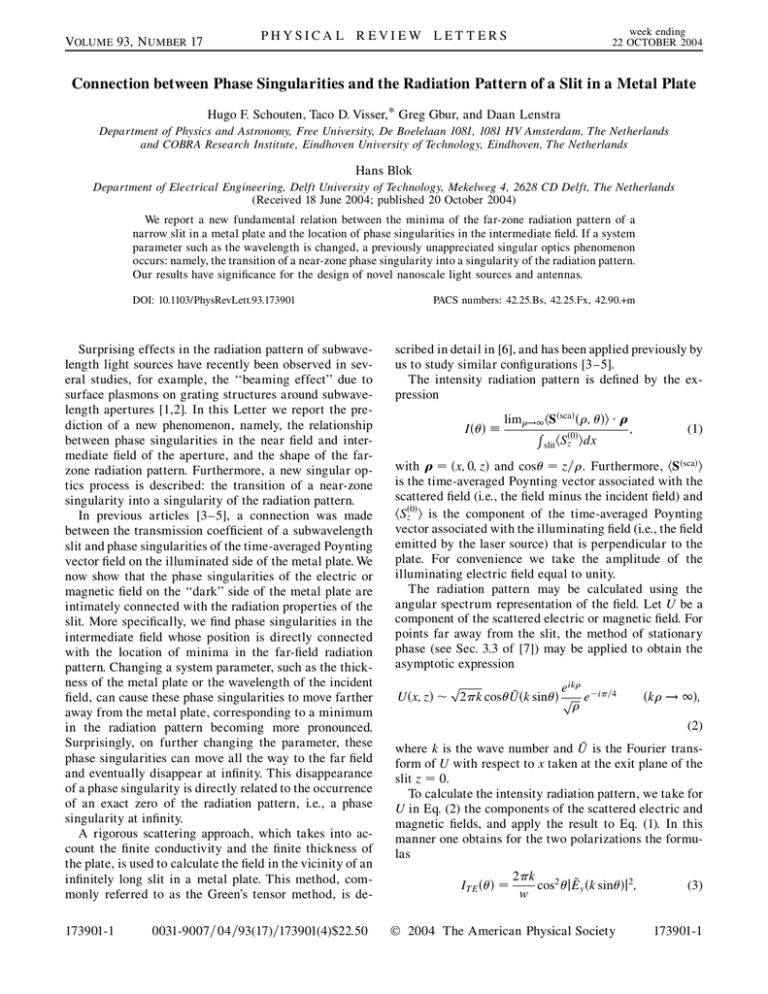
VOLUME 93, N UMBER 17 week ending 22 OCTOBER 2004 PHYSICA L R EVIEW LET T ERS Connection between Phase Singularities and the Radiation Pattern of a Slit in a Metal Plate Hugo F. Schouten, Taco D. Visser,* Greg Gbur, and Daan Lenstra Department of Physics and Astronomy, Free University, De Boelelaan 1081, 1081 HV Amsterdam, The Netherlands and COBRA Research Institute, Eindhoven University of Technology, Eindhoven, The Netherlands Hans Blok Department of Electrical Engineering, Delft University of Technology, Mekelweg 4, 2628 CD Delft, The Netherlands (Received 18 June 2004; published 20 October 2004) We report a new fundamental relation between the minima of the far-zone radiation pattern of a narrow slit in a metal plate and the location of phase singularities in the intermediate field. If a system parameter such as the wavelength is changed, a previously unappreciated singular optics phenomenon occurs: namely, the transition of a near-zone phase singularity into a singularity of the radiation pattern. Our results have significance for the design of novel nanoscale light sources and antennas. DOI: 10.1103/PhysRevLett.93.173901 Surprising effects in the radiation pattern of subwavelength light sources have recently been observed in several studies, for example, the ‘‘beaming effect’’ due to surface plasmons on grating structures around subwavelength apertures [1,2]. In this Letter we report the prediction of a new phenomenon, namely, the relationship between phase singularities in the near field and intermediate field of the aperture, and the shape of the farzone radiation pattern. Furthermore, a new singular optics process is described: the transition of a near-zone singularity into a singularity of the radiation pattern. In previous articles [3–5], a connection was made between the transmission coefficient of a subwavelength slit and phase singularities of the time-averaged Poynting vector field on the illuminated side of the metal plate. We now show that the phase singularities of the electric or magnetic field on the ‘‘dark’’ side of the metal plate are intimately connected with the radiation properties of the slit. More specifically, we find phase singularities in the intermediate field whose position is directly connected with the location of minima in the far-field radiation pattern. Changing a system parameter, such as the thickness of the metal plate or the wavelength of the incident field, can cause these phase singularities to move farther away from the metal plate, corresponding to a minimum in the radiation pattern becoming more pronounced. Surprisingly, on further changing the parameter, these phase singularities can move all the way to the far field and eventually disappear at infinity. This disappearance of a phase singularity is directly related to the occurrence of an exact zero of the radiation pattern, i.e., a phase singularity at infinity. A rigorous scattering approach, which takes into account the finite conductivity and the finite thickness of the plate, is used to calculate the field in the vicinity of an infinitely long slit in a metal plate. This method, commonly referred to as the Green’s tensor method, is de173901-1 0031-9007=04=93(17)=173901(4)$22.50 PACS numbers: 42.25.Bs, 42.25.Fx, 42.90.+m scribed in detail in [6], and has been applied previously by us to study similar configurations [3–5]. The intensity radiation pattern is defined by the expression I lim!1 hSsca ; i ; R 0 slit hSz idx (1) with x; 0; z and cos z=. Furthermore, hSsca i is the time-averaged Poynting vector associated with the scattered field (i.e., the field minus the incident field) and hS0 z i is the component of the time-averaged Poynting vector associated with the illuminating field (i.e., the field emitted by the laser source) that is perpendicular to the plate. For convenience we take the amplitude of the illuminating electric field equal to unity. The radiation pattern may be calculated using the angular spectrum representation of the field. Let U be a component of the scattered electric or magnetic field. For points far away from the slit, the method of stationary phase (see Sec. 3.3 of [7]) may be applied to obtain the asymptotic expression ik p ~ sin ep ei=4 Ux; z 2k cosUk k ! 1; (2) ~ is the Fourier transwhere k is the wave number and U form of U with respect to x taken at the exit plane of the slit z 0. To calculate the intensity radiation pattern, we take for U in Eq. (2) the components of the scattered electric and magnetic fields, and apply the result to Eq. (1). In this manner one obtains for the two polarizations the formulas ITE 2k 2 ~ cos jEy k sinj2 ; w 2004 The American Physical Society (3) 173901-1 PHYSICA L R EVIEW LET T ERS VOLUME 93, N UMBER 17 o -30 -60 o -90o 0o 30 ~ 1 k sin U ~ 2 k sineik2 k1 d j2 ; (5) I cos2 jU o o 60 90o FIG. 1. Polar plot of the (normalized) intensity radiation pattern of a 250 nm wide slit in a 100 nm thick silver plate with refractive index n 0:05 i2:87. The incident field has a wavelength 500 nm and is TE polarized (solid line) or TM polarized (dashed line). ITM 2k 0 ~ y k sinj2 ; cos2 jH w "0 (4) with 0 the vacuum permeability, "0 the vacuum permittivity, and w the slit width. In Fig. 1 the radiation pattern of a subwavelength slit is plotted both for TE-polarized (i.e., the electric field is parallel to the slit) and TM-polarized fields. The pattern is found to be rather uniform, i.e., the light is diffracted into every direction, with no minima being present in the radiation pattern. This is typical for subwavelength slits for both polarization cases —for such slits there is only one (propagating) guided mode possible. The radiation pattern is drastically changed if the slit width is increased, because then more modes in the slit become propagating. In the configuration of Fig. 1, the second symmetric mode is propagating for a slit width w > 1:4 for TE-polarized fields or w > 0:9 for TMpolarized fields [3]. (No antisymmetric modes are excited because the illuminating field is symmetric.) This implies that for such slit widths the intensity radiation pattern as a function of the plate thickness d is approximately given by [see Eqs. (3) and (4)] ~ i the Fourier transform with respect to x of a field with U component (E^ y for TE polarization, and H^ y for TM polarization) at the exit plane of the slit of mode i, and ki the effective wave number of mode i (i 1; 2). The exponential of the second term in Eq. (5) is periodic in k or d leading to alternate constructive and destructive interference of the two terms, which results in the radiation pattern periodically changing from having minima to having no minima. In the case that there is a minimum, the radiation pattern is more directional. If the field (E^ y for TE polarization and H^ y for TM polarization) behind the slit is plotted for cases such that the radiation pattern has minima, one typically finds a phase singularity in the direction of the radiation minimum; see Figs. 2 and 3. A phase singularity (also called a wave dislocation) is a point where the amplitude of the field is zero, and hence the phase of the field is undefined [8]. The gradient of the phase circulates around the singularity and such a phenomenon is often referred to as an optical vortex. Because of the continuity of the field, the phase change around a phase singularity is necessarily an integer number (usually 1) times 2. The topological charge s of a phase singularity is defined as s 1 I d 1; 2; . . . 2 C (6) with C a closed curve around the phase singularity and the phase of the field. The topological charge is a continuous function of the system parameters, as long as the contour C is chosen such that no phase singularity crosses z z x 1 µm FIG. 2 (color online). Polar plot of the intensity radiation pattern of a 600 nm wide slit in a 750 nm thick silver plate (shaded region) with refractive index n 0:05 i2:87. Also the positions of the phase singularities of H^ y in the region behind the slit are shown. L denotes a left-handed phase singularity, and R denotes a right-handed phase singularity. The incident light (coming from below) has a wavelength 500 nm and is TM polarized. 173901-2 week ending 22 OCTOBER 2004 x 0.5 µm FIG. 3 (color online). The intensity radiation pattern of a 750 nm wide slit in a 860 nm thick silver plate (n 0:05 i2:87). Also the positions of the phase singularities of E^ y behind the slit are shown. The incident light has a wavelength 510 nm and is TE polarized. 173901-2 VOLUME 93, N UMBER 17 week ending 22 OCTOBER 2004 PHYSICA L R EVIEW LET T ERS the contour. Because s is also an integer, the topological charge is conserved. In Figs. 2 and 3 two phase singularities are present, one with charge 1 (left-handed) and one with charge 1 (right-handed). In Fig. 2 (TM polarization) phase singularities in H^ y are shown, whereas in Fig. 3 (TE polarization) phase singularities in E^ y are shown. For both cases, each of these phase singularities gives rise to a vortex (circulation) in the field of power flow. The connection between these two kinds of phase singularities is explained in detail in [4]. The phase singularities in Figs. 2 and 3 are found by numerically calculating the topological charge [see Eq. (6)]. In this way, we can determine if there is an actual phase singularity present, or just a minimum in the intensity. In Figs. 3 and 4 the phase singularities near the slits as well as the radiation pattern are plotted for two values of the wavelength of the incident field. It is seen that for 510 nm (Fig. 3) the phase singularities are closer to the plate and the minima are less pronounced than for 500 nm (Fig. 4). This behavior was found to be typical for this kind of configuration (see, e.g., Fig. 2 for another case with pronounced minima and phase singularities behind the slit). If the wavelength is decreased even more, a curious phenomenon is observed: the phase singularities move away towards the far zone, and at a certain value of the wavelength it is no longer possible to track them numerically. The minima in the intensity radiation pattern correspondingly become deeper with decreasing wavelength until at a certain critical wavelength, the minima evidently become true zeros. For wavelengths smaller than this critical wavelength, the value of the intensity at the minima rises as a function of decreasing wavelength. To investigate this behavior more closely, we quantify the phase behavior at infinity by first introducing for E^ y (or for H^ y for TM-polarized fields) the reduced field E^ red y defined by the expression ik e ; : E^ y ; p E^ red y Next we take the limit for the phase red ; of E^ red y , inf lim red ; ArgE~y k sin =4; (8) !1 where we used Eq. (2). Near the wavelength where the intensity of the radiation pattern for one particular angle of observation is almost zero, the phase at infinity shows the behavior plotted in Fig. 5. It is seen that for a wavelength 490 nm there is a rapid increase of the phase by near the angle 36 where a minimum of the radiation pattern occurs, whereas for 489 nm the phase rapidly decreases by an amount of near the same angle. A similar behavior was found for several configurations for the TM-polarization case. A physical interpretation of this surprising behavior is provided by noting that in principle two cases can occur: either the phase singularities remain present at a finite distance from the slit (apparently far from the slit) or the phase singularities disappear at infinity. It is instructive to introduce the function ; ! ; arctan, which maps the upper half space behind the slit into the half disk f0 ; 0 : =2 0 =2; 0 0 arctan =2g. The phase of the reduced field E^ red y is well defined on this space, even on the boundary 0 =2, where it is given by the limit value inf of Eq. (8). The disappearance of a phase singularity at infinity can be observed in the behavior of the phase at infinity inf . This effect is illustrated in Fig. 6: if the phase singularity z 2 2π 1.5 3π/2 I(θ ) 0.5 µm 0.5 0 -90 -60 -30 0 30 60 angle of observation θ [deg] FIG. 4 (color online). The intensity radiation pattern of a 750 nm wide slit in a 860 nm thick silver plate (n 0:05 i2:87). Also the position of the phase singularities of E^ y behind the slit are shown. The incident light has a wavelength of 500 nm and is TE polarized. 173901-3 π/2 φ inf (θ ) π 1 x (7) 0 90 FIG. 5. The intensity radiation pattern (dotted curve) and the far-field phase behavior of a 750 nm wide slit in a 860 nm thick silver plate (n 0:05 i2:87). The incident light is TE polarized and has a wavelength of 490 nm (solid line) or 489 nm (dashed line). 173901-3 VOLUME 93, N UMBER 17 (a): radiation minimum +π PHYSICA L R EVIEW LET T ERS (b): radiation zero (c): radiation minimum −π ρ ' = π/2 FIG. 6 (color online). Illustration of the disappearance of a phase singularity at infinity when the wavelength of the field is gradually decreased. A sketch of the equiphase lines of red 0 ; is drawn, which on the semicircle 0 =2 takes on the value inf . Three cases are depicted: in (a) the phase singularity is still present, corresponding to a radiation minimum; in (b) the phase singularity is exactly at infinity, corresponding to a radiation zero; in (c) the phase singularity is no longer present, corresponding to a radiation minimum. In this example the singularity is taken to have a topological charge s 1. is present at a large, but finite, distance from the slit, the situation on the left-hand side of the figure applies: near the angle where the phase singularity is present, the phase at infinity changes rapidly, but continuously, by (it increases by when the angle of observation is increased if the topological charge is 1, whereas it decreases by if the topological charge is 1). If the wavelength is decreased, the phase singularity can be exactly at infinity, i.e., at the boundary 0 =2, as is shown in the middle of Fig. 6. In this case there is an exact zero in the radiation pattern, together with a phase jump at this point. If the wavelength is decreased even further, then the right-hand side of Fig. 6 applies: the phase singularity does not exist anymore. However, a ‘‘residual effect’’ can still be observed in the phase behavior at infinity: the phase rapidly changes by . Note that if initially there was a increase when the angle is increased, now there is a decrease. It is to be further noted that this phase behavior at infinity is possible only if some phase singularity ‘‘crosses’’ the boundary 0 =2, i.e., 1. However, it is impossible to distinguish between a phase singularity with charge s 1 disappearing at infinity and a phase singularity with charge s 1 appearing at infinity. Because in our results (see Fig. 5) there was a phase singularity moving to the far zone, this suggests that this phase singularity has disappeared at infinity, as discussed above. Note that this implies that the topological charge is not (locally) conserved. However, because of the mirror symmetry of the system, the positive and 173901-4 week ending 22 OCTOBER 2004 negative charges at infinity disappear together—that is, the total topological charge of the field is conserved, even though the singularities disappear at widely separated spatial locations. These results suggest a new singular optics phenomenon, in which a singularity in the near or intermediate zone [a singularity in two-dimensional x; z space] converts into a singularity in the radiation pattern (one-dimensional space). It is to be noted that other researchers [9] have studied the motion of phase singularities as system parameters are changed, in what is usually referred to as the theory of combined beams. This work, unlike our study, does not discuss the effects of phase singularities on the radiation pattern of the field. In summary, we have shown that there is a connection between minima in the far-zone radiation pattern and phase singularities in the intermediate field. On changing a system parameter, these singularities can move to infinity and become singularities of the radiation pattern. A possible way to experimentally verify the predicted relation between phase singularities and the radiation pattern is to place a thin nanowire at a phase singularity and align it parallel to the slit. The presence of the wire should not affect the observed radiation pattern in the far zone [10]. These results provide a new insight into the behavior of radiation patterns, and are therefore important for the design of nanoscale light sources and antennas [10,11]. This research is supported by the Dutch Technology Foundation STW. *Electronic address: tvisser@nat.vu.nl [1] H. J. Lezec, A. Degiron, E. Devaux, R. A. Linke, L. Martı́n-Moreno, F. J. Garcı́a-Vidal, and T.W. Ebbesen, Science 297, 820 (2002). [2] L. Martı́n-Moreno, F. J. Garcı́a-Vidal, H. J. Lezec, A. Degiron, and T.W. Ebbesen, Phys. Rev. Lett. 90, 167401 (2003). [3] H. F. Schouten, T. D. Visser, D. Lenstra, and H. Blok, Phys. Rev. E 67, 036608 (2003). [4] H. F. Schouten, T. D. Visser, G. Gbur, D. Lenstra, and H. Blok, Opt. Express 11, 371 (2003). [5] H. F. Schouten, T. D. Visser, G. Gbur, D. Lenstra, and H. Blok, J. Opt. A Pure Appl. Opt. 6, S277 (2004). [6] T. D. Visser, H. Blok, and D. Lenstra, IEEE J. Quantum Electron. 35, 240 (1999). [7] L. Mandel and E. Wolf, Optical Coherence and Quantum Optics (Cambridge University Press, Cambridge, 1995). [8] M. S. Soskin and M.V. Vasnetsov, in Progress in Optics, edited by E. Wolf (Elsevier, Amsterdam, 2001), Vol. 42. [9] M. S. Soskin, V. N. Gorshkov, M.V. Vasnetsov, J. T. Malos, and N. R. Heckenberg, Phys. Rev. A 56, 4064 (1997). [10] F. Landstorfer, H. Meinke, and G. Niedermair, Nachrichtentechn. Z. 25, 537 (1972). [11] P. de la Fuente, Ph.D. thesis, Technischen Universität München, 1975. 173901-4
